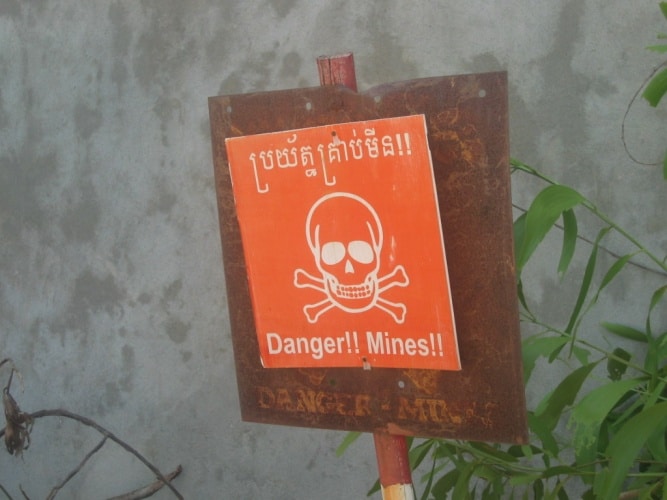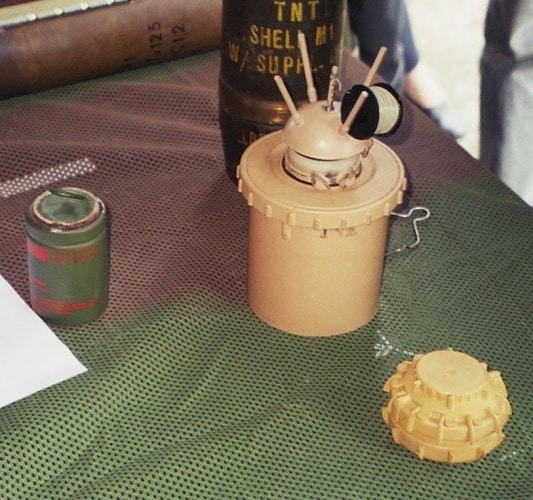
This week saw a number of high profile figures including Stephen Hawking, Tesla and SpaceX founder Elon Musk, and Apple co-founder Steve Wozniak come together to sign an open letter warning of the dangers of weaponised artificial intelligence (AI). The letter argued that AI has reached a point where deployment of robotic weapons is feasible, and that humanity must act to prevent the proliferation of autonomous offensive machines.
Autonomous weapons are described in the letter as those that “select and engage targets without human intervention”. There exists today, however, a weapon which does exactly that, and is deployed in about 70 different countries around the world. Landmines, once placed in the ground, effectively engage targets without human intervention, silently waiting for friend or foe to enter their blast range, killing and maiming indiscriminately.
Of course, landmines are not the type of ‘smart’ weaponry that Musk and Hawking are warning about. But if a landmine actually could ‘think’, and distinguish between a soldier and a child, it would be a far less terrifying and brutal weapon. It is the very randomness with which the landmine inflicts its damage that makes it such a blight worldwide, often on populations threatened by poverty, where the land is relied upon for subsistence.

It’s estimated that there are 110 million landmines buried across the world, the vast majority a deadly legacy from wars long past. The actual number, frightening as it may be, is perhaps less important than the impact that landmines have on communities. It takes only a handful of mines - or even the suspicion of their presence – to discourage the use of land.
This week saw Kurdish fighters claim that ISIS had planted “thousands” of landmines as they retreated from the northern Syrian city of Hasakah, rendering 15 villages around the city uninhabitable. “They plant large mines that are easily detonated so young boys are blown to pieces,” one commander told NBC News. “We need help. We don’t have the technology or techniques to defuse them.”
This same problem is one that persists in current and former warzones across the globe. Sweeping for and clearing landmines is a tricky business - time-consuming, expensive and dangerous. An individual landmine can cost as little as £2 to make, but takes anywhere between £120 and £600 to find and clear. What’s more, today’s landmines are usually made of plastic, rendering traditional detection techniques useless.
Earlier in the week I wrote about a project underway at the University of Bath to develop a new method of detection that will be able to identify both metallic and non-metallic mines. The project is being funded by Find A Better Way (FABW), the charity set up by Sir Bobby Charlton in 2011 after visiting the minefields of Cambodia. Using a combination of 3D camera technology and metal detection, the new system aims to create a subsurface image, pinpointing the mines below.

“The innovative idea in this project is a combination of capacitive array and inductive array, so that both classification of electrical properties and detection of non-metallic and metallic landmine can be done,” Dr Manuchehr Soleimani, the lead researcher on the project, told me.
“The capacitive array works a bit like a touch screen, and the inductive array is like a metal detector. We’re hoping to develop a compact, low-cost version of this combined smart camera that can be deployed in landmine detection.”

Meanwhile, a slightly less technical, but no less impressive technique for landmine detection is being used in Cambodia. Teams of Gambian pouched rats are trained to sweep the fields, sniffing out the TNT of landmines and other unexploded ordnance. With the help of a single rat, a 200 square metre patch of land can be cleared in just 30 minutes – something that would take a deminer two or three days according to the rats’ handler.
Whether it’s the latest 3D imaging technology, or a crack squad of TNT-sniffing rats, the need for a more effective and accessible method of clearing minefields is evident. Musk and Hawking have both identified AI as the biggest existential threat that humanity faces, and it may well indeed enslave us all one day, or simply wipe us out. Regardless, we should at least be trying to make our planet as inhabitable as possible in the meantime, where vast tracts of land aren’t given over to the scourge of landmines, and millions tread in fear for life and limb.




Nanogenerator consumes CO2 to generate electricity
Nice to see my my views being backed up by no less a figure than Sabine Hossenfelder https://youtu.be/QoJzs4fA4fo